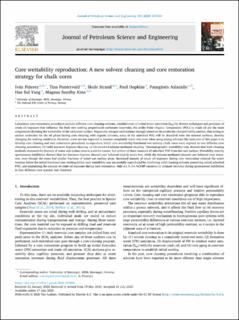| dc.contributor.author | Piñerez Torrijos, Iván Darío | |
| dc.contributor.author | Puntervold, Tina | |
| dc.contributor.author | Strand, Skule | |
| dc.contributor.author | Hopkins, Paul Andrew | |
| dc.contributor.author | Aslanidis, PANAGIOTIS | |
| dc.contributor.author | Yang, Hae Sol | |
| dc.contributor.author | Kinn, Magnus Sundby | |
| dc.date.accessioned | 2023-02-09T13:40:47Z | |
| dc.date.available | 2023-02-09T13:40:47Z | |
| dc.date.created | 2020-08-07T10:27:01Z | |
| dc.date.issued | 2020 | |
| dc.identifier.citation | Pinerez, I., Puntervold, T., Strand, S., Hopkins, P., Aslanidis, P., Yang, H. S., & Kinn, M. S. (2020). Core wettability reproduction: A new solvent cleaning and core restoration strategy for chalk cores. Journal of Petroleum Science and Engineering, 195, 107654. | en_US |
| dc.identifier.issn | 0920-4105 | |
| dc.identifier.uri | https://hdl.handle.net/11250/3049777 | |
| dc.description.abstract | Laboratory core restoration procedures include different core cleaning solvents, establishment of initial water saturation (Swi) by diverse techniques and processes of crude oil exposure that influence the final core wetting properties.In carbonate reservoirs, the acidic Polar Organic Components (POC) in crude oil are the main components dictating the wettability of the carbonate surface. Negatively charged carboxylates strongly attach to the positively charged CaCO3 surface, thus acting as anchor molecules for the oil phase.During core cleaning with organic solvents, some of the adsorbed POC will be detached from the mineral surfaces, thereby changing the wetting conditions. However, cores are not expected to become completely water-wet even when using strong solvents.The main aim of this paper is to develop core cleaning and core restoration procedures to reproduce initial core wettability.Fractional-wet outcrop chalk cores were exposed to two different core cleaning procedures, (1) mild kerosene-heptane cleaning, or (2) standard toluene-methanol cleaning. Chromatographic wettability tests showed that both cleaning methods increased the fraction of water-wet surface area to a similar extent, but neither of them removed all adsorbed POC from the rock surface. Wettability tests by spontaneous imbibition showed that the kerosene-heptane cleaned core behaved slightly water-wet, while the toluene-methanol cleaned core behaved very water-wet, even though the cores had similar fractions of water-wet surface areas. Increased amount of crude oil exposure during core restoration reduced the water wetness below the initial fractional core wetting.Initial core wettability was successfully reproduced by combining mild cleaning solvents preserving initial adsorbed POC, and minimizing the amount of crude oil exposure during core restoration. Only a 1.5–3.6 %OOIP variation in ultimate recovery during spontaneous imbibition in four different core systems was observed. | en_US |
| dc.language.iso | eng | en_US |
| dc.publisher | Elsevier | en_US |
| dc.rights | Navngivelse 4.0 Internasjonal | * |
| dc.rights.uri | http://creativecommons.org/licenses/by/4.0/deed.no | * |
| dc.title | Core wettability reproduction: A new solvent cleaning and core restoration strategy for chalk cores | en_US |
| dc.type | Peer reviewed | en_US |
| dc.type | Journal article | en_US |
| dc.description.version | publishedVersion | en_US |
| dc.rights.holder | The authors | en_US |
| dc.subject.nsi | VDP::Teknologi: 500 | en_US |
| dc.source.journal | Journal of Petroleum Science and Engineering | en_US |
| dc.identifier.doi | 10.1016/j.petrol.2020.107654 | |
| dc.identifier.cristin | 1822143 | |
| dc.relation.project | Norges forskningsråd: 230303 | en_US |
| dc.relation.project | IOR-senteret - økt oljeutvinning: 8090 | en_US |
| cristin.ispublished | true | |
| cristin.fulltext | original | |
| cristin.qualitycode | 2 | |

